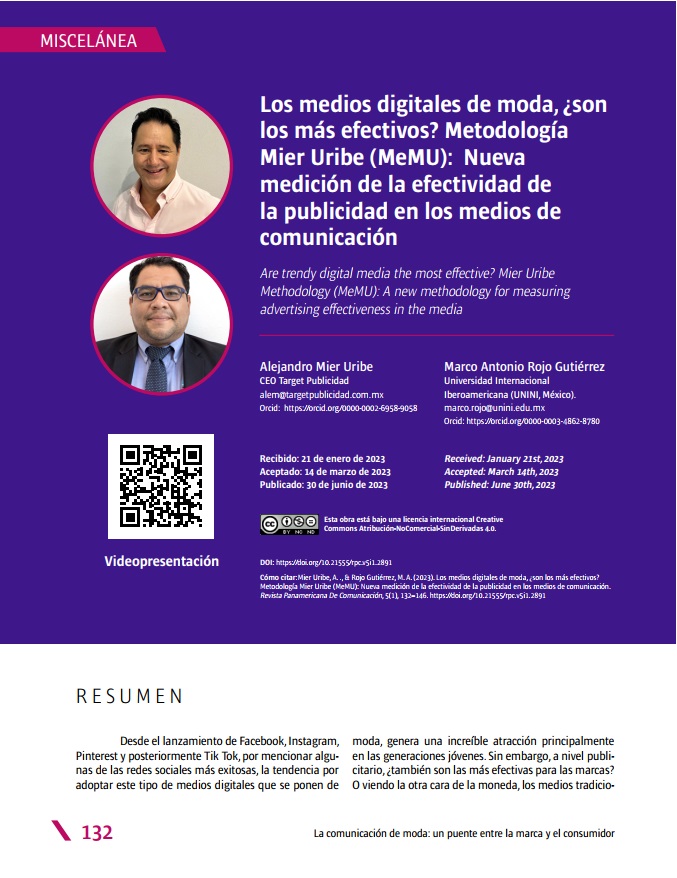Los medios digitales de moda, ¿son los más efectivos? Metodología Mier Uribe (MeMU): Nueva medición de la efectividad de la publicidad en los medios de comunicación
Contenido principal del artículo
Resumen
Desde el lanzamiento de Facebook, Instagram, Pinterest y posteriormente Tik Tok, por mencionar algunas de las redes sociales más exitosas, la tendencia por adoptar este tipo de medios digitales que se ponen de moda, genera una increíble atracción principalmente en las generaciones jóvenes. Sin embargo, a nivel publicitario, ¿también son las más efectivas para las marcas? O viendo la otra cara de la moneda, los medios tradicionales offline, totalmente fuera de moda para las nuevas generaciones, ¿ya no son efectivos como medios publicitarios? La publicidad históricamente ha tenido diversos métodos para medir sus resultados; sin embargo, a través de las décadas, los líderes de la industria han señalado muchas falencias en las mediciones y dudas acerca de si los medios seleccionados realmente son los más efectivos (mayor impacto a menor costo). La incertidumbre crece en la medida que a los medios tradicionales offline se suma una gran diversidad de medios digitales online. Estas y muchas incógnitas más las respondemos a través de la nueva Metodología Mier Uribe (MeMU) cuyo objetivo es garantizar contratar a los medios más efectivos. Mediante cuatro investigaciones, MeMU identifica el mercado específico del producto a anunciar, los medios que consume ese mercado, el nivel de impacto de cada uno de esos medios y, finalmente, un comparativo de costos. Como resultado, MeMU garantiza contratar a los medios más efectivos para cualquier producto en cualquier ciudad en la que se anuncie.
Detalles del artículo
Sección

Esta obra está bajo una licencia internacional Creative Commons Atribución-NoComercial-SinDerivadas 4.0.
Cómo citar
Referencias
» Aldás J. (1998). Modelos de determinación de la cobertura y la distribución de contactos en la planificación de medios publicitarios impresos [Tesis doctoral, Universidad de Valencia, España]. https://core.ac.uk/download/pdf/71030335.pdf
» Arroyave V., Montoya, M. (2013). La eficacia publicitaria en el contexto antioqueño. https://cutt.ly/96C0Hbc
» Elósegui T. & Muñoz G. (2019). Mejor que ventas consigue clientes. Social business.
» Godin S. (2002). La vaca púrpura. Gestión.
» Hopkins C. (1999). Publicidad científica. https://cutt.ly/l6C092J
» IAB México, Asociación de internet, ave, CiM (2022). Estudio Valor Total Media 2022. https://estudiototalmedia.mx
» INEGI (2020). Encuesta Nacional sobre Disponibilidad y Uso de Tecnologías de la Información en los Hogares (ENDUTIH) 2020. https://www.inegi.org.mx/contenidos/saladeprensa/boletines/2021/OtrTemEcon/ENDUTIH_2020.pdf
» Izco E. (2007). Los adolescentes en la planificación de medios. Segmentación y conocimiento del target. Instituto de la Juventud (INJUVE).
» Kotler P. & Armstrong G. (2013). Fundamentos del marketing. Pearson.
» Kotler P., Kartajaya H. & Setiawan I. (2019). Marketing 4.0. LID.
» Kotler P., Kartajaya H. & Setiawan I. (2021). Marketing 5.0. Wiley.
» Lamas C., AIMC. (2004). La medición de la audiencia de los medios. https://www.aimc.es/a1mc-c0nt3nt/uploads/2010/10/medicion_audiencia_el_publicista.pdf
» Navarro F. (2010). Del ágora al rating: medición de audiencias. http://biblioteca.diputados.gob.mx/janium/bv/ce/scpd/LXI/agora.pdf
» Nielsen. (2022). Digital Ad Rating. https://www.nielsen.com/es/solutions/audience-measurement/digital-ad-ratings/?gclsrc=aw.ds
» Ogilvy D. (1963). Confesiones de un publicitario. http://biblio3.url.edu.gt/Libros/2011/con_publi.pdf
» Ries A. & Trout J. (1999). Las 22 leyes inmutables del marketing. McGraw Hill education.
» Sampson H. (1874). A history of advertising from the earliest times. Anboco.
» Sotelo R. (2022). La inversión en publicidad crecerá un 8,7% a nivel mundial en 2022 gracias al impulso del sector digital. Marketing 4 Ecommerce.
» Zyman S. (2002). El fin de la publicidad como la conocemos. Mc-Graw Hill.

